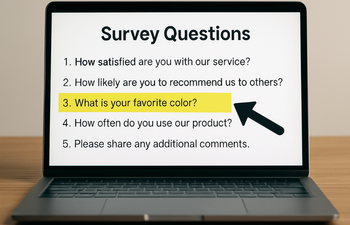How to Avoid Leading Questions in Surveys (With Real Examples)
Learn how to avoid leading questions in surveys with real examples and expert tips to create unbiased, effective survey questionnaires.

Introduction
Creating a survey is more than just jotting down a few questions and hitting "send." If you're aiming for reliable, unbiased, and actionable data, there's one thing you must absolutely avoid: leading questions. These subtle traps can distort results, introduce bias, and ultimately undermine the credibility of your survey. This article explores how to avoid leading questions in surveys, with real-life examples, clear explanations, and actionable tips.
What Are Leading Questions?
Leading questions are those that prompt or encourage a specific response, intentionally or unintentionally. These questions steer respondents toward a particular answer, often aligning with the survey creator's assumptions or biases. While they might seem harmless, the impact on data integrity is significant.
Why Avoiding Leading Questions Is Crucial
When surveys are skewed by leading questions, the results can't be trusted. Poor data leads to poor decisions. Imagine launching a new product or policy based on biased feedback, it’s a recipe for failure. Avoiding leading questions ensures that the data reflects genuine opinions and insights.
Real Examples of Leading Questions
Let’s look at some common examples to illustrate what a leading question looks like, and how to fix it.
How Leading Questions Skew Data
Leading questions can:
- Create false positives or inflated ratings.
- Suppress genuine criticism or concerns.
- Lead respondents to provide answers they think the surveyor wants.
- Invalidate statistical analyses by misrepresenting true variance.
These distortions reduce the overall reliability of your research.
Common Traits of Leading Questions
Watch out for these common signs:
- Emotionally charged or persuasive language.
- Assumptions about the respondent’s behavior or beliefs.
- Implied approval or disapproval.
- Limited or biased answer choices.
Recognizing these patterns is the first step to eliminating bias from your surveys.
The Psychology Behind Leading Questions
Cognitive psychology reveals that people are more likely to conform to perceived social norms. If a question suggests what the "right" answer is, respondents may choose it even if it's not their true opinion. This is especially true in workplace surveys, political polls, or sensitive subjects.
The Impact on Decision-Making
Misleading survey results can lead to poor decisions. For instance, a business might invest in a feature customers don't actually want, or a nonprofit might advocate policies that don't reflect community needs. That’s why survey integrity is critical.
How to Write Neutral Survey Questions
Follow these golden rules for neutral phrasing:
- Avoid implying judgment or expectations.
- Use balanced wording and unbiased terminology.
- Offer all plausible answer choices.
- Pilot-test the questions with a small group first.
Simple tweaks in wording can yield dramatically more reliable data.
Real-Life Example: Political Polls Gone Wrong
In one infamous case, a poll asked:
"Do you support the government’s plan to protect children from harmful online content?"
The question was intended to gauge support for internet regulation. But its wording biased respondents toward agreement. A more neutral alternative would be:
"Do you support or oppose the current internet content regulation proposal?"
Leading vs. Loaded Questions
While both introduce bias, loaded questions make assumptions that may not be true. For example:
A leading question:
"How helpful was our excellent support team?"
A loaded question:
"Have you stopped ignoring our customer support messages?"
Both should be avoided in high-quality survey design.
Techniques to Spot and Revise Bias
Use these practical techniques to review your survey:
- Read questions aloud and listen for implied opinions.
- Ask a colleague to review for neutrality.
- Use A/B testing with alternative question wordings.
- Analyze pilot data for skewed response distributions.
These checks ensure your survey reflects the true voice of respondents.
Avoiding Bias in Question Options
Bias can also creep in through answer choices. For example:
Poor:
"How often do you shop with us? (Often, Always, Very Often)"
Better:
"How often do you shop with us? (Never, Rarely, Sometimes, Often, Always)"
Balanced scales are essential to capturing honest feedback.
Avoiding Double-Barreled Questions
A double-barreled question asks about two things at once:
"How satisfied are you with our pricing and product quality?"
Respondents might have different opinions on each aspect, leading to confusion and inaccurate data. Break it into two questions instead.
Cultural and Linguistic Bias
Certain phrases might be loaded with meaning in one culture but neutral in another. Always tailor your language for your audience, and if you're surveying a global group, consider localization or professional translation.
The Role of Pretesting
Before launching your survey, pretest it with a small, diverse group. Their feedback can help you identify unclear or biased questions. It’s a small step that yields a major return.
Using Anonymous Responses to Reduce Bias
Sometimes, respondents skew answers because they fear judgment. Offering anonymity encourages honest, uninfluenced answers, particularly with sensitive topics.
Digital Tools That Help Flag Bias
Survey tools like Qualtrics, SurveyMonkey, or Typeform often include features to test or warn about biased language. Use these tools to build cleaner, smarter surveys.
Collaborate with Experts
If you're new to survey design or dealing with a high-stakes project, consult a professional researcher. Their expertise can save you from common pitfalls and improve the accuracy of your data.
Building a Bias-Free Survey Culture
Make neutral survey design a company-wide standard. Train your team, use templates, and build internal best practices for collecting honest feedback.
Benefits of Neutral Survey Design
Designing neutral, bias-free surveys results in:
- Increased respondent trust and participation.
- More accurate and actionable insights.
- Better strategic decisions based on solid data.
- Stronger credibility of your research or brand.
The payoff is well worth the effort.
Final Checklist for Avoiding Leading Questions
Before launching any survey, go through this checklist:
- 1Are any words emotionally charged?
- 2Do questions assume facts or behaviors?
- 3Are answer options balanced?
- 4Was the survey pretested?
- 5Did you get a second pair of eyes?
For insights on balancing survey length for better data, visit Short vs. Long Online Surveys: Which One Gets Better Data?.
This habit builds discipline into your survey design process.
How to Avoid Leading Questions in Surveys
Avoiding leading questions is a foundational skill in survey design. It's not just about being neutral, it's about being fair, accurate, and respectful of your respondents. By applying the insights and examples shared here, you can ensure your surveys provide reliable data and meaningful insights.
For a deeper dive into leveraging single-question surveys for actionable insights, check out Unlocking Growth: The Power of a Single NPS Survey Question.
Conclusion
Creating surveys that deliver honest, valuable data is not just a technical challenge, it's a moral and professional responsibility. By learning how to avoid leading questions in surveys, you protect the integrity of your data and earn the trust of your audience. Whether you're a business, researcher, nonprofit, or government agency, bias-free survey design will elevate your outcomes and your credibility.
Frequently Asked Questions
Find answers to the most common questions about this topic
A leading question subtly prompts the respondent to answer in a particular way, often reflecting the surveyor's bias.
They introduce bias and compromise the validity of the survey results by influencing how respondents answer.
Look for emotionally charged language, assumptions, or wording that implies a 'correct' answer.
Use neutral, balanced wording that doesn't assume or suggest an answer. Allow for a full range of responses.
Yes, many leading questions result from unintentional bias or poor survey design rather than deliberate manipulation.
They skew results and make it difficult to interpret data accurately, often invalidating the insights you can draw from the survey.









